Billionton Systems GUBTCR42T Bluetooth USB Dongle User Manual
Billionton Systems, Inc. Bluetooth USB Dongle
User Manual
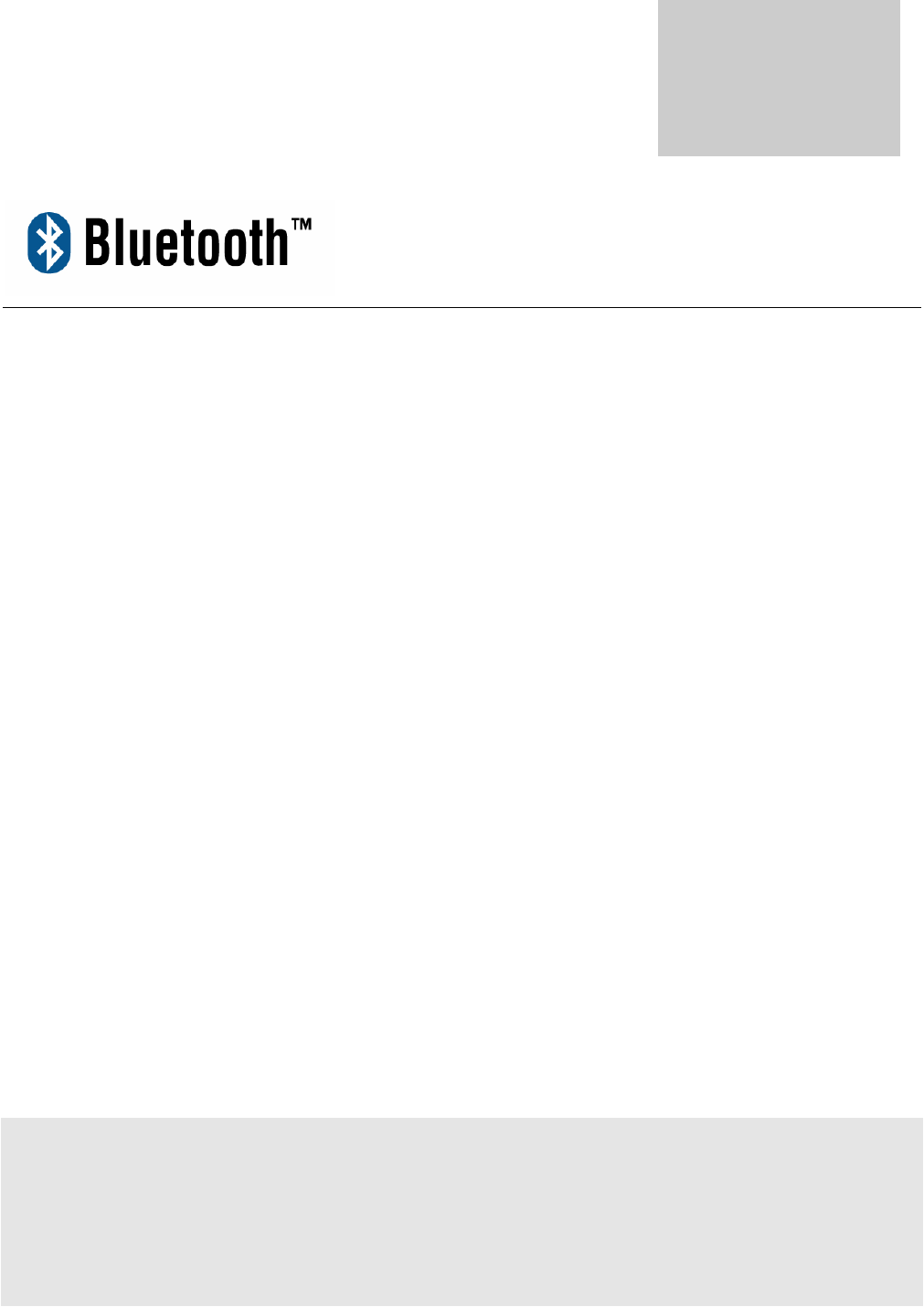
USB Adapter
Installation Guide
1.6.1

Index
INTRODUCTION 1
CHAPTER1
Package 2
Features 2
Specifications 2
Mechanics 3
Certification 4
Environmental Operating Ranges 4
Power Consumption 4
Drivers support 4
CHAPTER2
Setup for Windows 98/ME/2000/XP 5
Setup for Mac 8
Know Bug 8

1
Introduction
Bluetooth is an open specification for a cutting-edge technology that enables short-range
wireless connections between desktop and laptop computers, personal digital assistants,
cellular phones, printers, scanners, digital cameras and even home appliances — on a
globally available band (2.4GHz) for worldwide compatibility. In a nutshell, Bluetooth
unplugs your digital peripherals and makes cable clutter a thing of the past. Now you can
connect your PDA or PC to Bluetooth™ enabled mobile phone with this Bluetooth™
adapter.
You can access e-mail & Internet no matter where you are with just a little help from your
Bluetooth™ mobile phone.
Plus, when you are back in the office, you can hook yourself up to your office network as
well as communicate with other Bluetooth™-enabled devices.
i

2
Chapter1
Package
z One Bluetooth adapter
z Companion CD(including driver, software, and Installation guide)
Features
z Bluetooth v1.1, 1.2, 2.0+EDR compliant
z USB Bluetooth adapter support full speed USB v1.1 Interface.
z Wireless communication within a radius of 32 Feet (10 Meters) for Class 2
Bluetooth devices.
z Wireless communication within a radius of 328 Feet (100 Meters) for Class 1
Bluetooth devices.
z Connect up to 7 different Bluetooth enabled devices
z Encryption and authentication to ensure safe, secure communications
z Low power consumption
Specifications
z Hardware:
Main chip: CSR BlueCore 03 or 04
Protocol: Bluetooth 2.4 GHz ISM band frequency hopping
Data Rate: 721 Kbps or 2~3Mbps
Connect up to 7 devices in a Piconet
Antenna: Integrated inside the adapter
For Class 2 Bluetooth radio (2.23dBm):
Connection within a range of up to 32 feet (10 meters)
For Class1 Bluetooth radio:
1

3
Connection within a range of up to 328 feet (100 meters)
Sensitivity: -80dbm at 0.1% Bit Error Rate (BER)
Security: encrypted link, authentication
z Software:
Bluetooth profile support includes:
A/V Remote Control Profile (AVRCP)
Adv. Audio Dist. Profile (A2DP)
Generic Access Profile (GAP)
Serial Port Profile (SPP)
Service Discovery Application Profile (SDAP)
Generic Object Exchange Profile (GOEP)
Object Push Profile (OPP)
File Transfer Profile (FTP)
Dial-up Network Profile (DUN)
LAN Access Profile (LAP)
Fax Profile (FAX)
Synchronization Profile
Headset Profile
Personal Area Network (PAN)
Human Interface Device (HID)
Hardcopy Cable Replacement Profile (HCRP)

4
Mechanics
46 x 18 x 10 mm (L x W x H) (for Class 2)
46 x 18 x 10 mm (L x W x H) (for Class 1)
Certification
FCC, CE, BQB
Environmental Operating Ranges
Temperature: 0 ~ 50%
Humidity: 10 ~ 90%
Power Consumption
Typical: 40mA/5V
Maximum: 90mA/5V
Drivers support
Windows 98SE, ME, 2000, XP, MAC O.S. 10.2.x
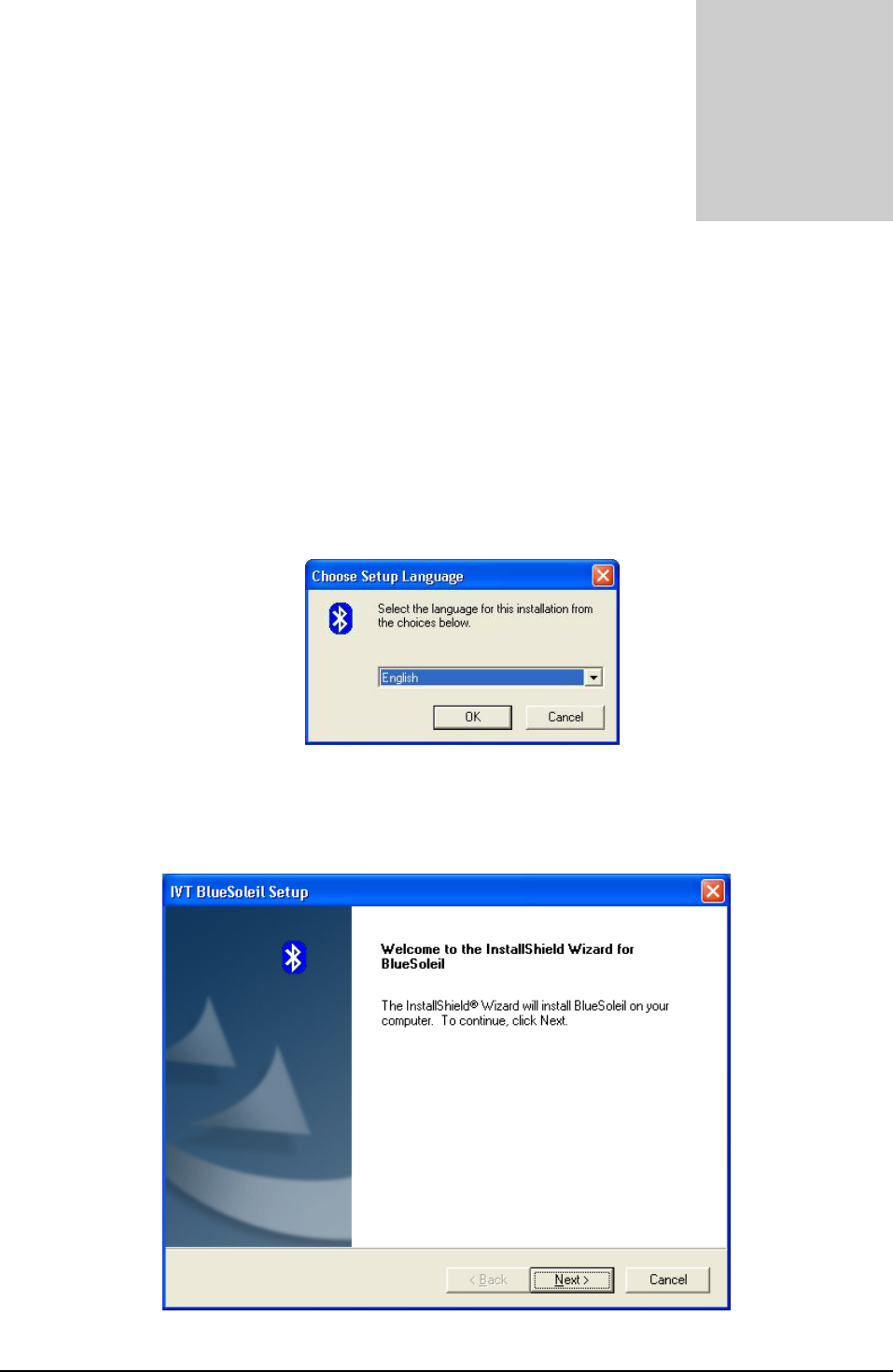
5
Chapter2
Setup for Windows 98SE/ME/2000/XP
Installing Bluetooth software for Windows
1. Place installation CD into PC and the setup menu should launch automatically.
If the setup menu does not launch automatically, use Windows Explorer to navigate to the
appropriate CD-ROM drive and run "Setup". Language screen will pop-up for selection.
2. Complete the following steps to install Bluetooth software:
On the Welcome screen, click the “Next“button.
2
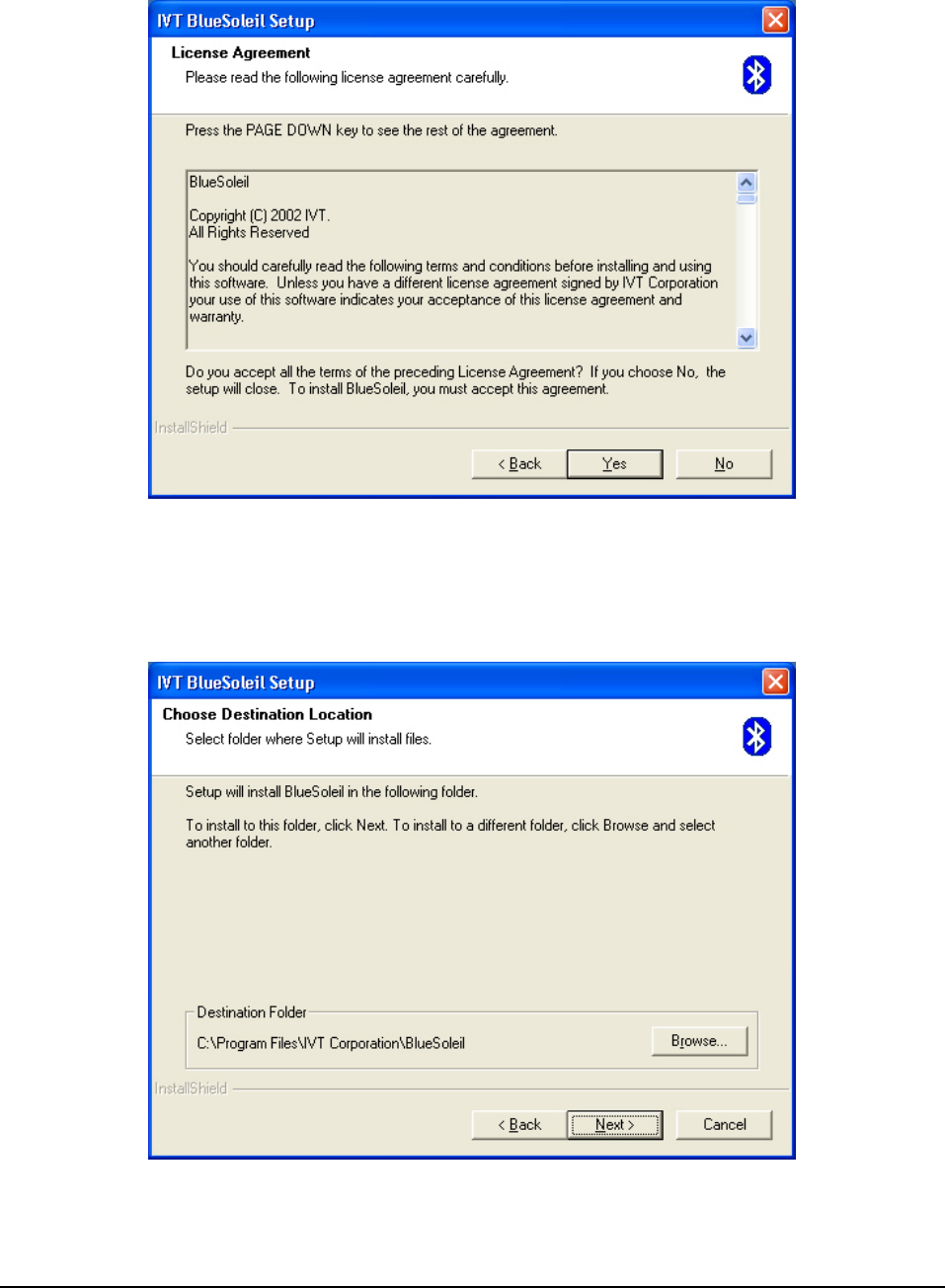
6
When the License Agreement screen is displayed, read the License Agreement, and then
clicks the “Yes“button.
a. You can choose the destination folder in your system, if you do not want to change
the destination folder please click “Next“. On the Destination Folder screen, click
the “Browse” button to browse to a new destination folder for the Bluetooth
software. Otherwise, click the “Next“button to accept the default folder.
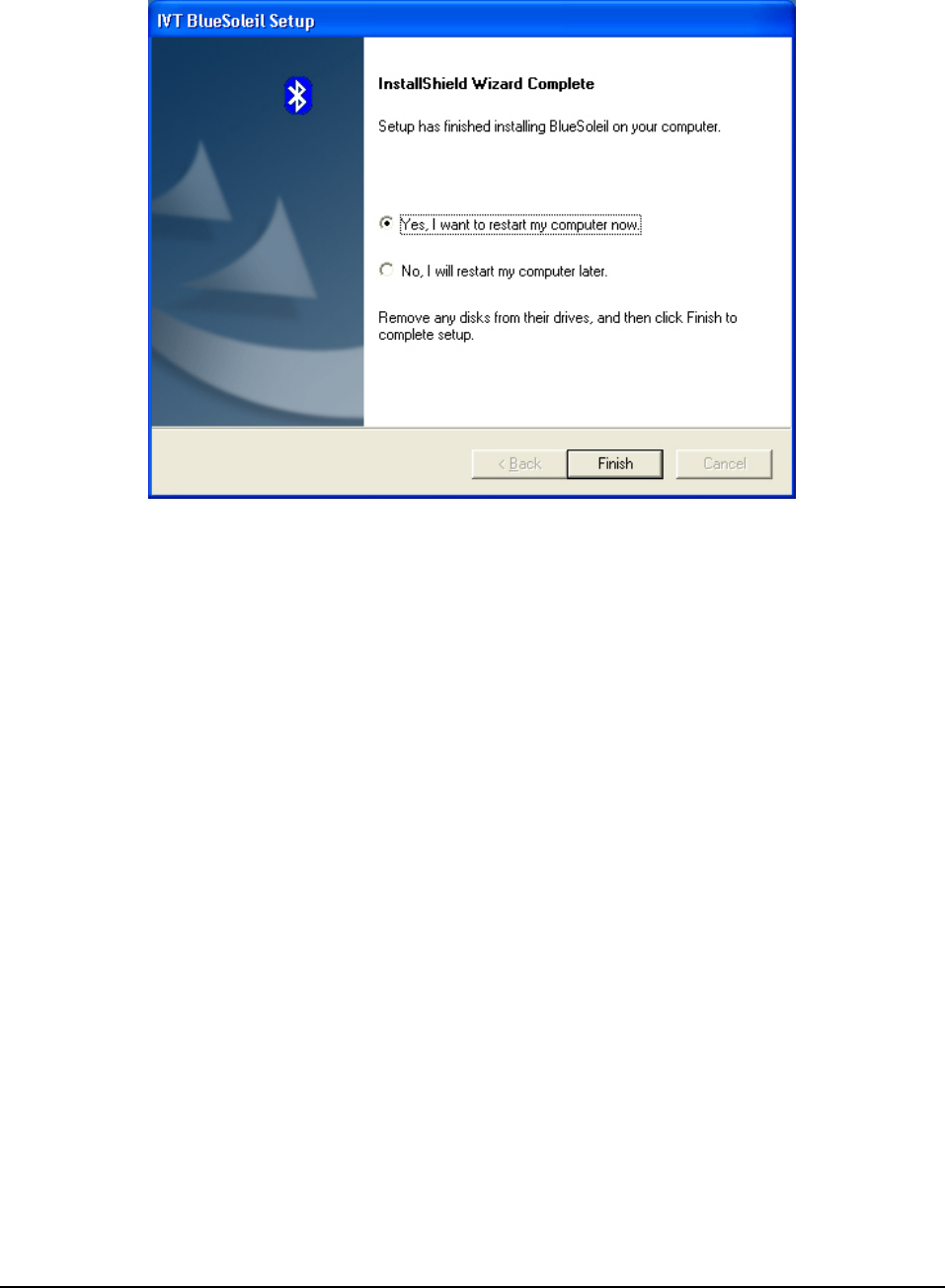
7
b. When the installation is completed, please select “Yes, I want to restart my
computer now.”, then click the "Finish" button.
c. After the computer restarts, you have to plug the USB Bluetooth adapter in your
USB port. Driver will be installed automatically. If system fails to find the driver, you
can browse the path “C:\Program Files\IVT Corporation\BlueSoleil\driver\USB\”.
If you have any questions, please refer to “Hardware User Guide”.
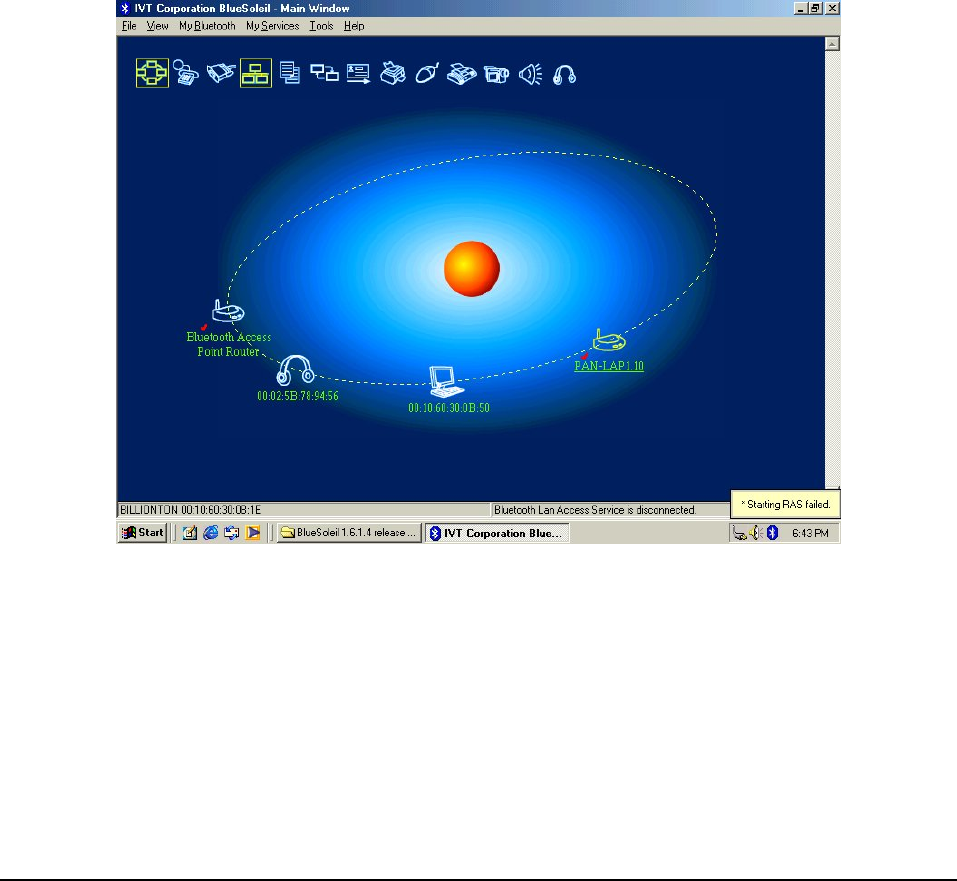
8
Setup for Mac
Mac O.S.X 10.2
Mac O.S. 10.2.x has build-in Bluetooth software for USB Bluetooth adapters; therefore no
additional Bluetooth software is required. Simply plug in the USB Bluetooth adapter and a
Bluetooth icon will appear in the System folder. Open the Bluetooth applet to configure the
Bluetooth functions on your Mac system.
Know Bug
Window 98/ME
When the user select the Bluetooth Access Point (PAN-LAP 1.10) icon under Window
98/ME system, an error message”*Starting RAS failed” will appear (see figure below). The
LAP function may not be functional either. This problem will be fixed in the next release.
FCC statement in User's Manual (for class B)
"Federal Communications Commission (FCC) Statement
This Equipment has been tested and found to comply with the limits for a class B digital
device, pursuant to Part 15 of the FCC rules. These limits are designed to provide reasonable
protection against harmful interference in a residential installation. This equipment generates,
uses and can radiate radio frequency energy and, if not installed and used in accordance with
the instructions, may cause harmful interference to radio communications. However, there is
no guarantee that interference will not occur in a particular installation. If this equipment
does cause harmful interference to radio or television reception, which can be determined by
turning the equipment off and on, the user is encouraged to try to correct the interference by
one or more of the following measures:
- Reorient or relocate the receiving antenna.
- Increase the separation between the equipment and receiver.
- Connect the equipment into an outlet on a circuit different from that to which the receiver is
connected.
- Consult the dealer or an experienced radio/TV technician for help.
FCC Caution:
1.The device complies with Part 15 of the FCC rules. Operation is subject to the following
two conditions:
(1) This device may not cause harmful interference, and
(2) this device must accept any interference received, including interference that may
cause undesired operation.
2.This device and its antenna(s) must not be co-located or operating in conjunction with
any other antenna or transmitter.
3. Changes or modifications to this unit not expressly approved by the party responsible
for compliance could void the user authority to operate the equipment.
In addition to the requirements of Section 7.1.5 in RSS-Gen, the device's shall also
contain the following or equivalent statement: “Privacy of communications may not
be ensured when using this telephone”.
If privacy is provided as a standard feature, the privacy notice may be omitted
provided that full justification accompanies the equipment certification application for
evaluation by Industry Canada.

Europe-EU Declaration of Conformity and Restrictions
Hereby, Tecom Co., Ltd., declares that this equipment complies with the essential requirements and other
relevant provisions of Directive 1999/5/EC.
This equipment is marked with the symbol and can be used throughout the European community.
This indicates compliance with the R&TTE Directive 1999/5/EC and meets the relevant parts of following
technical specifications:
EN 300 328 v1.6.1 - Electromagnetic compatibility and Radio spectrum Matters (ERM); Wideband
Transmission Systems; Data transmission equipment operating in the 2,4GHz ISM band and using
spread spectrum modulation techniques; Harmonized EN covering essential requirements under article
3.2 of the R&TTE directive.
EN 301 489-17 v1.2.1 - Electromagnetic Compatibility and Radio Spectrum Matters (ERM);
Electromagnetic Compatibility (EMC) standard for radio equipment and services; Part 17 Specific
Conditions for Wideband Data and HIPERLAN Equipment.
EN 60950-1: 2001 - Safety of Information Technology Equipment.
EN 50371: 2002 - Generic standard to demonstrate the compliance of low power electronic and electrical
apparatus with the basic restrictions related to human exposure to electromagnetic fields
(10 MHz-300GHz) - General public